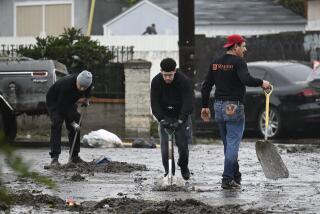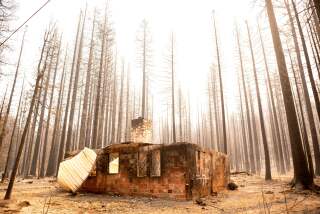Farmers in a cold sweat over potential damage to crops and livestock
As unseasonably cold weather continues to blanket western states, farmers are bracing for potentially painful damage to crops and livestock that could drive up consumer prices.
The true effect won’t be known for weeks, but growers such as California’s citrus farmers are working through the nights trying to protect $2 billion worth of fruit.
“There’s no question there’s damage,” said Barney Evans, vice president of sales for Sun Pacific, headquartered in Pasadena and owner of Cuties brand Clementine oranges. “But it’s going to take two to three weeks after the cold snap to evaluate” the extent.
Sun Pacific growers, like many others in the citrus industry, have been turning on their irrigation systems at night when temperatures have reached freezing point. The water can warm conditions a few degrees. Wind machines are also employed to circulate the warmer air — filling parts of the San Joaquin Valley with the whir of fans through the evenings and early mornings.
Such protection isn’t cheap. California Citrus Mutual, a trade association representing more than two-thirds of the state’s citrus farmers, estimates that frost protection over the last six nights has cost the industry about $23 million.
“Equipment fatigue and fuel supply are the concern now,” said Alyssa Houtby, a spokeswoman for California Citrus Mutual. “In six nights, wind machines have run for an average of 56 hours and field reports indicate that mechanical issues may inhibit frost protection efforts for the duration of this freeze.”
The fear is a repeat of catastrophic winters in 1990 and 1998 that cost the citrus industry hundreds of millions of dollars and left thousands of farmhands out of work. Early indications suggest the weather won’t be as bad this time, with warming expected in the following days.
“The cold weather we are experiencing now is by no means comparable to the severe temperatures and damage incurred” in the 1990s, said Joel Nelson, president of California Citrus Mutual. “The frost protection technology we have today has allowed producers to better prepare for freeze conditions and protect the crop from serious damage.”
Still, with the harvest for many citrus crops starting in January, wholesalers and retailers are anxious to know how severely supplies will be diminished by the cold.
The big chill is threatening other California crops as well. Some walnut growers are protecting their fledgling trees with irrigation. And some produce picking is behind schedule, said Dave Kranz, a spokesman for the California Farm Bureau Federation.
“You might see some temporary reduction in fresh vegetables in the desert valleys because they can’t start harvesting until later in the day when the ice starts to thaw,” Kranz said. “Whether this translates to prices at the grocery store is hard to know now.”
The same calculations are being made in the nation’s meat and dairy industries, said Bill Tierney, chief economist for AgResource, a Chicago research firm. Cattle struggle to gain weight when they’re eating primarily to stay warm. Heavy snow could disrupt logistics, whether it’s for supplying feed to animals or delivering herds to market.
“Tough winters reduce beef supplies and support higher prices,” Tierney said. “Given that we’re near record highs in beef prices, a small disruption may make things tighter.”
Small farmers face some of the biggest challenges. Most don’t get big subsidies or hedge potential losses on futures markets.
Thaddeus Barsotti, owner of Capay Organic north of Sacramento, grows citrus and vegetables that he ships directly to households across California.
He said his carrots and fennel have sustained some freeze damage — minor blemishes that would be rejected by major grocery chains. But because the flavor hasn’t been diminished, customers have not complained, he said.
His main concern is his 40 acres of Satsuma oranges and five acres of Meyer lemons. He said he planted the trees on high ground to keep them away from dense cold air that tends to hug the low ground. He also chose hardy varieties that can handle temperatures as low as 25.
Still, he’s been turning on his irrigation around midnight the last week for extra protection.
“The most stressful thing is you have to wait weeks to see if they survived,” Barsotti said. “I’m looking out the window now and the trees look cold and tired but alive.”
Barsotti hopes they stay that way. But as a farmer, he knows he’s always at the mercy of nature.
“You just learn to deal with the cold,” Barsotti said. “There’s not a lot you can do. It’s all in the planning where you have the power. Then you just have to watch how things play out.”







